The greatest delay moments of all time: 25 classic guitar tracks elevated by echo
The exemplars of echo, the doyens of digital and the analog innovators that made delay pedals a pedalboard perennial for guitar players
11. The Police – Walking on the Moon
Guitarist: Andy Summers
Another guitarist whose life was changed upon discovering the Maestro Echoplex, Andy Summers had the perfect guitar style to jive with effects such as modulation and delay. He largely eschewed distortion for crystal cleans and light crunch, and his chord and note choices were ripe for some extra processing.
Summers used an MXR Dyna Comp compressor, almost as a matter of good signal hygiene, before sending the tone right on round the bend with an Electro-Harmonix Electric Mistress.
But tracks such as Walking on the Moon are made magical once the Echoplex is engaged. Indeed, there is something anti-gravity about that sparse intro, Summers’ guitar stabbing around Sting’s bassline. Most of the melodic information is carried by Sting, but that ambient fairy dust is sonically and thematically perfect.
Speaking to Guitar World, Summers said the Echoplex became a signature move from early on, a feature of the end of Can’t Stand Losing You.
“I managed to acquire more things, but the big move was getting the Echoplex,” he said. “because I found that I was able to add another dimension to the band in terms of the reverb, and the largeness and scale of the sound.”
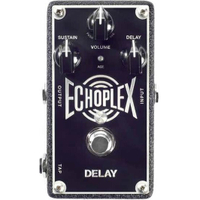
Gear pick: Dunlop EP103
Approved by Summers himself, the EP103 is a reliable stand-in for the less-than-reliable vintage Echoplex.
12. Elvis Presley – Mystery Train
Guitarist: Scotty Moore
Get The Pick Newsletter
All the latest guitar news, interviews, lessons, reviews, deals and more, direct to your inbox!
The earliest examples of delay in popular music were found in slapback echo of early rock ’n’ and roll, and none were better than the King’s own six-string lieutenant through his Sun Studio era, Scotty Moore.
Producer Sam Phillips has got to take some of the credit here, too. Set the repeats to a quarter-second or less, and set the feedback so there’s just a few of them – quite literally slapping back at you – and you’ve got it.
The effect through a clean tube combo is deeply evocative of rock ’n’ roll’s foundational moment. It officially became part of Moore’s rig in 1955 when, inspired by Chet Atkins, he acquired one of these new-fangled Ray Butts’ EchoSonic amplifier with an onboard tape echo.
In putting his 1954 Gibson L-5 CESN through the EchoSonic, Moore defined rockabilly guitar tone. Over 65 years later, Mystery Train still sounds exhilarating. Moore would switch to a Gibson Super 400 but the idea was the same, and the tone would go on to change pop culture for keeps. The rockabilly cat was out of the back and there was no turning back.
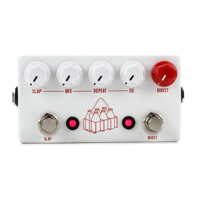
Gear pick: JHS Milkman
A two-in-one slapback echo and boost, the Milkman is compact and rockabilly-ready. You just need some pomade in your hair and you’re good to go.
13. St. Vincent – Now, Now
The natural harmonic chime of St. Vincent’s Now, Now takes on an extra-dimensional quality with her clever use of pitch-shifting and a fast delay time that adds the illusion that the guitar is being doubled.
Few players use effects so imaginatively. Pop, no matter how avant-garde or aesthetically bold, can be a hard medium for the electric guitar, but St. Vincent’s has the touch.
She makes full use of this gilded era in effects pedals, curating a ‘board with a number of pitch-shifting, fuzz and delay options, finding a way to bend guitar tone out of shape and fold it into the mix. Whenever the tone is a little cleaner, the delay is almost omnipresent in her work, allowing her to tease out longer ambient textures without them turning to mush as they might with reverb.
On Now, Now, the delay makes it busy, while the pitch-shifter attracts a double take from an audience whose ears are surely deceiving them. This… is guitar?
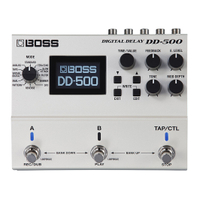
Gear pick: Boss DD-500 Digital Delay
Stacked with features, the DD-500 does it all, and makes a superb all-in-one unit for creative delays.
14. Audioslave – Cochise
Guitarist: Tom Morello
Animal, vegetable, mineral, whatever – you name it and the man Morello will take out his guitar and mimic it. He’s like a myna bird, a player whose skill-set calls to mind Michael Winslow of Police Academy fame. And it’s amazing how this one-man sound effects unit can dip into the onboard presets stored in his brain and augment rock with weird textures.
The whirlybird chopper effect that opens Cochise is one of Morello’s best effects. Set the delay for a single repeat with a short delay time and set it at a level just under your dry signal. Mute the strings with your fretting hand and tap out the rhythm on the low E with your picking hand.
Move your fretting hand position to adjust the pitch of the blades. Play around with this sort of thing and other ideas will come to mind. It’s a little like the choppiest tremolo you have ever heard, and it’s very rad.
The best bit about trying to master Morello’s trick bag is that you don’t need much. Phaser, Whammy, wah, delay, and you’ve got all you need.
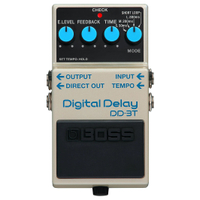
Gear pick: Boss DD-3T
It’s one of the best delays on the market, great value, and Morello uses a DD-3 himself.
15. John Martyn – Rather Be The Devil
John Martyn’s Rather Be The Devil did for the acoustic guitar what Eddie Van Halen’s Eruption did for electric guitar. This act of brazen iconoclasm, using a DeArmond pickup mounted in the soundhole and a tape echo to accentuate his fingerstyle rhythms and warp the tone, inspired a new generation of players.
Where Martyn went, the likes of John Smith and Ben Howard followed, amassing banks of delay and echo. Speaking to Total Guitar, John Smith recalled one of the formative moments in his career, playing the Barbican in London – a big deal – and not having a soundcheck because Martyn’s vintage Roland Space Echo had gone rogue.
Watching the video above from Martyn’s performance at the BBC is incredible. The only thing that suggests it was the 1970s is the screen resolution and the fashion. Otherwise, this is 21st-century guitar playing, and for anyone with a mind to embrace the possibilities of electric tech for the acoustic form, Martyn is essential listening.
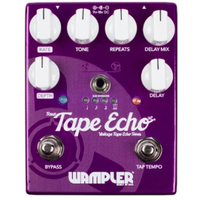
Gear pick: Wampler Faux Tape Echo V2
Vintage tape mojo with a digital brain, this Wampler unit is a tweaker’s delight, and guaranteed to be more reliable than that vintage Echoplex you saw on eBay.
16. Steve Vai – Ballerina 12/24
Steve Vai’s Passion and Warfare is one of shred guitar’s foundational texts. Every track has something to teach us. In the case of 12/24 Ballerina, it’s how some delay and clever pitch shifting can put a pin in the record for a jewelry box guitar instrumental. Countless forum pages are dedicated to Vai’s tone secrets on this. Such is the onward march of technological progress it is getting more accessible by the day.
The studio magic of the Eventide H3000 Ultra-Harmonizer now is available in a compact form, in most good guitar stores, and yet it will never fail to amaze us. The trick is having the imagination to design such an an outré guitar tone on your device and then have the wherewithal to turn something so unlike the guitar into a guitar piece. We prefer the idea of some angels whispering the tone secrets and chord changes into the ear, just as they surely back at the Mothership.
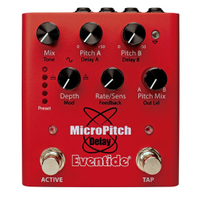
Gear pick: Eventide MicroPitch Delay
A delay/pitch-shifter featuring Eventide’s H910, H949 and H3000 algorithms, the MicroPitch is everything you need to write in frequencies more amendable to Tinkerbell and friends.
17. Radiohead – Karma Police
Guitarist: Ed O’Brien
The mindwarping conclusion to Karma Police is one of those OK Computer moments where the force of Ed O’Brien’s genius takes centre stage and – quite literally – multiplies before our ears.
An anxious, disembodied and alienating composition, it finishes with a self-oscillating wormhole, created by O’Brien running his guitar through an AMS DMX 15-80S rack-mounted digital delay.
Now, maxing out the repeats is always interesting until a delay self-oscillates is always fun. It is 100 per cent guaranteed to get your dog to howl along – trust us, we’ve tried it. But it’s not necessarily musical.
It’s the context that makes it so vital, and how O’Brien pulls back the delay speed to adjust the pitch and further loosen the bonds between reality and the subverted reality in which Radiohead pitch this track. Once it’s through, you want to take yourself to the shower to wash the mood off. The thing is, by the end of Karma Police that unease is under the skin.
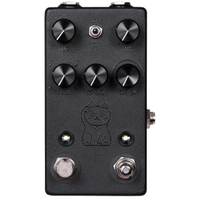
Gear pick: JHS Lucky Cat
An underrated delay that’s built like a tank with heaps of features, stick the Lucky Cat in tape mode, max out repeats and play around with the time for some oscillating madness.
18. Flock of Seagulls – I Ran (So Far Away)
Guitarist: Paul Reynolds
Not enough has been written on the guitar playing of Paul Reynolds. Maybe it’s because the new wave sound of Flock of Seagulls has been ring-fenced by the passing of time and never adequately reanimated in the 21st century to merit a thorough audit of Reynolds’ genius.
But he makes a fascinating case study in how to make an electric guitar work outside of the analog confines of rock ’n’ roll and the modern beat combo format. In a sense, it is players such as Reynolds who paved the way for St. Vincent et al.
One of the difficulties when talking about great pop songs such as I Ran (So Far Away) is that the melody and the ensemble steamroller your attention, but iris in on the guitar playing and you’ll find Reynolds with his super-wacky 1980 Kramer XL-5 (aluminum neck FTW), playing through a Roland RE-501 Chorus Echo.
Roland’s last mechanical echo unit was a beast – if you find one online in good condition expect to pay over $2,000 – that featured spring reverb, echo and chorus. Unlike other tape echoes, the tape was held in its own compartment as opposed to being wound on a cassette, all to prolong tape life and offer more pristine, wow/flutter-free performance for longer.
While we do not know exactly what Reynolds used when tracking I Ran, it was certainly a go-to unit for live performances. On record, it is a textbook exercise in new wave guitar tone, clean processed tones, dotted-eighth delay times and a pseudo-doubling effect to make the solo really pop out. Having all but defined new wave guitar playing, Reynolds is ripe for rediscovery.
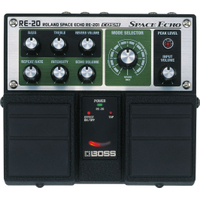
Gear picks: Boss RE-20 Space Echo Pedal
This digital recreation of the Roland RE-201 Space Echo doesn't have the chorus, but it does have reverb and an awesome tape echo emulation that’s ideal for fashionably arty ‘80s tones.
19. Van Halen – Cathedral
Guitarist: Eddie Van Halen
If you look at his rig and some of the outré styles he had showcased on previous recordings, it was inevitable that Eddie Van Halen would get around to tracking something like Cathedral.
If Eruption introduced us to his flamboyant gift for performance and meticulous technique, Cathedral gave him the opportunity to demonstrate just how all of the elements of his rig could be brought to bear on the urgent task of advancing rock guitar.
This is what the EVH gear low-friction volume pot is for. Yeah, sure, use a volume pedal, you can’t walk about the stage, making eye contact and greeting the people when rooted to your ‘board.
In Eddie’s hands, those volume swells, the double-locking vibrato and the Maestro Echoplex created a strange brew of audio magic. The Echoplex’s legendary preamp adds a little heat to the "brown sound", but also allowed his guitar to transmogrify into a synthesized organ and have a conversation with itself.
It’s like that bit in Close Encounters when the NASA cats and the aliens are having a jam off, except it’s all with one guitar and one man having a god-like moment of genius. On record it is ecclesiastic, onstage was a mind-bending spectacular.

Gear pick: Strymon Volante Magnetic Echo
You get three echo types here, but for Cathedral, set it to tape with a delay time for just under 400ms. Besides enabling some bedroom Cathedral, the Volante is one of the most powerful echo machines ever made.
20. Covet – Nero
Guitarist: Yvette Young
The most important effect in Yvette Young’s signal chain is Yvette Young. Of course, she has a fully stocked pedalboard, but really, you could just give her an Ibanez Talman and a capo and send her into the studio and she’ll come up with some gold. But that said, when she uses analog delay on tracks such as Nero, she finds an extra level.
It’s funny because many players will use a compressor as their tone-sweetener, or maybe an EP-3 preamp-style boost, but on Nero, it is as though there’s a Carbon Copy delay working with a compressor to make that solo sound extra pro.
There is something admirably high-wire about that choice, because as much as delay can thicken things up it can also create clutter if the playing is not on-point. This is lo-fi, analog virtuosity, a form of radical transparency that makes Covet, and Young’s playing in particular, so thrilling.
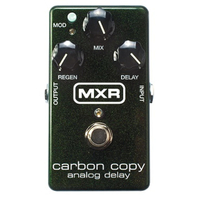
Gear pick: MXR M169 Carbon Copy
Arguably the best analog delay on the market, and a no-brainer on any ‘board.
Jonathan Horsley has been writing about guitars since 2005, playing them since 1990, and regularly contributes to publications including Guitar World, MusicRadar and Total Guitar. He uses Jazz III nylon picks, 10s during the week, 9s at the weekend, and shamefully still struggles with rhythm figure one of Van Halen’s Panama.











